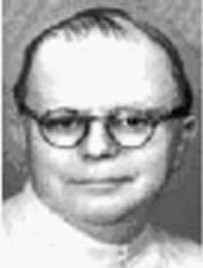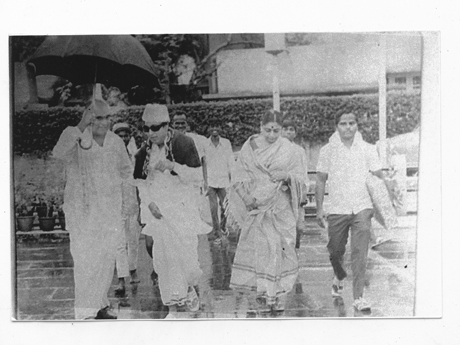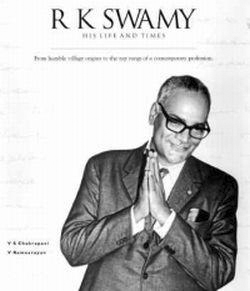| (ARCHIVE) Vol. XXI No. 2, May 1-15, 2011 |
|
Quick Links
Masters of 20th Century Madras science
Cricket in the days of 'The Cardusian'
A 'talkies' with a history
Advertising in Chennai
|
|
In the early- and mid-20th Century Mathematics of India, two French names figure prominently: Andrew Weil and Charles Racine. Whereas Weil spent most of his time in North India at Aligarh Muslim University, Racine served in Madras for most of his life.
 Charles Racine |
Racine was born in Tomay-Charente, Western France, in 1897. He entered the Society of Jesus in 1919 after a stint in the Great War and was ordained a priest in 1929. Racine obtained his Docteur es Sciences degree in Mathematics, working with Elie Joseph Cartan and Jacques Salomon Hadamard, legendary names in French mathematics, from the University of Sorbonne (Paris) in 1934. He came to India and joined St. Joseph’s College, Trichinopoly. In 1939, he moved to Loyola College, Madras, to head the Department of Mathematics and stayed there till his retirement in 1968.
Racine’s classes were research method-driven, contrary to the manner of preparing students for success in their examinations, which is the Indian education system. In the 1930s and 1940s, with K. Ananda Rao, a noted mathematical analyst, R. Vaidyanathaswamy, an eminent abstract mathematician, and Racine in Loyola College, Madras was seen as the best place in India for studying Mathematics and starting into mathematical research.
Racine and Vaidyanathaswamy promoted interest in modern Mathematics. Instead of following the tradition of teaching only classical analysis and analytic number theory, they introduced the new mathematical structures and modern algebra, which were being developed by the Bourbaki group in France. Racine also encouraged his students to read the latest books, such as the one on distributions by L. Schwartz. Racine was largely instrumental in enabling a bright young mathematician of that time, S. Minakshisundaram, to find a position.
Racine wrote three books and published many research papers. He was responsible for placing India on the contemporary map of Mathematics. The Government of France conferred the Legion d’ Honeur on him for his contributions to Mathematics and university education in India. He was the President of the 38th Indian Science Congress held in Bangalore in 1951.
With such a background, Racine naturally had an excellent perspective on Mathematics, which he brought from continental Europe to India with him. He began weaning some Indian mathematicians away from traditional Cambridge-inspired areas into the then contemporary European thinking in Mathematics; some of his outstanding students were: Venugopal Rao, P.K. Raman, M.S. Narasimhan, C.S. Seshadri, Ramabhadran, K. Varadarajan, Raghavan Narasimhan, C.P. Ramanujam, Ramabhadran Narasimhan, Ananda Swarup, S. Ramaswamy, Cyril D’Souza, Christopher Rego, V.S. Krishnan and S. Sribala. Racine encouraged his best students to join the then newly established Tata Institute of Fundamental Research (TIFR) in Bombay. This explains why so many Madras mathematicians from that generation (K.G. Ramanathan, S. Minakshisundaram, C.S. Seshadri, M.S. Narasimhan, R. Narasimhan and C.P. Ramanujam) were leaders at TIFR.
Racine died in Madras in 1976 and is interred in the Loyola College Jesuit Cemetery.
Back to top
|
|
|
|
|
I have had a long innings as a professional cricket writer, but the fondest memories are those of covering league cricket in Madras (as it was then known) from the late 1960s to the early 1980s. I joined the Indian Express in June 1968 as a sports reporter and was overjoyed to learn that cricket would be my beat. As a fanatical follower of the game since my pre-teen days, it pleased me no end to find that I would be going around the city, reporting on the senior division league matches and other cricket tournaments.
In those days the Rajah of Palayampatti Shield matches were played over one day, generally on Sundays and public holidays. And so my Sundays were spent going from ground to ground to cover the six matches. I well remember the Indian Express carrying the full scorecards of every senior division league match along with a fairly detailed report of every game – very different from the skimpy and inadequate coverage given in the newspapers these days. Shuttling between Marina and Chepauk or between University Union and Pachaiyappa’s or between ICF and Southern Railway or between Vivekananda and Gandhinagar made for a pleasurable duty and I looked forward eagerly to Sundays.
Those were the days when thousands would converge on the various grounds to see the matches and this added considerably to the atmosphere. Their favourite haunt was the Marina and a match between Jolly Rovers and State Bank would see the stand on the western side (later demolished to accommodate the MRTS service) jam-packed, with hundreds more all around the ground and many more on the beach side catching the action. It was a Sunday outing for cricket fans and they would really get involved with the proceedings, shouting for this team or that and applauding a fine batting or bowling performance.
The competition for supremacy was intense and the standard of cricket high. It had to be so, with all the leading cricketers in the State taking part. The importance of league matches could not be overemphasised for a good performance could well be the stepping stone to a place in the State under-25 squad for the Ramachandra Rao Trophy or even the Ranji Trophy team. There were, of course, other avenues too, for the Buchi Babu tournament had been revived in the late 1960s while the collegiate cricket scene was very encouraging. Inter-collegiate tournaments were organised by various colleges, and the Madras University had its own competition for the Duncan Trophy.
It was, of course, impossible to cover all matches, though my colleague M.S. Nagarajan and I tried to go to as many venues as we could. We also had a feature ‘City League Parade’ in the newspaper wherein we carried a short write-up along with photographs of cricketers who had done well in the league matches.
Sometime in the 1970s the full scorecard was given up due to pressure on space, but reports on league cricket, inter-collegiate games and representative matches continued to be fairly extensive. And I still carry fond memories of N.S. Ramaswami’s rather scholarly writings – with a romantic touch – on the lower division league matches in his popular column ‘In the pavilion’ which he wrote under the nom de plume ‘The Cardusian’.
Back to top
|
|
|
|
|
Sri Murugan Talkies, at No. 70 St. Xavier Street, Seven Wells, Chennai 600 001, was founded by landed gentry, Murugesh Mudaliyar, in 1917. His son, V.M. Paramasiva Mudaliyar, followed in his footsteps. And now Paramasiva Mudaliyar’s sons are carrying on the legacy.
 The Murugan Talkies today. |
Even the commute to the cinema hall is a travel back in time. Taking the bus to Tiruvottriyur, I get down at Walltax Road and wend my way through the quaintly named, narrow Telegraph Abbey Lane, Kanchipuram Sabapathy Street, and Kuppier Street in Kondithope, Chennai 79.
Says Managing Partner V.P. Balasubramaniam, one of the sons of VMP, a few plays had been staged in the theatre, Kaliya Narthanam for one. Then, during the silent movie era, when the theatre was called ‘Kinema Central’, it showed movies of Laurel and Hardy and Charlie Chaplin, among others. In 1931, India’s first talkie, Alam Ara, and in the same year Tamil’s first talkie, Kalidas, were shown here. During a few intervening years the theatre was called the ‘Majestic’.
 M.G. Ramachandran and Janaki Ramachandran visiting V.M. Paramasiva Mudaliyar's house. |
In days gone by, cinema-goers used to flock to the theatre, arriving in bullock carts! Those were the days when audiences sat on the floor and watched the films.
In 1928, a second theatre, ‘Prince’, was added to the present one, but it had to close down after six months because of “licensing problems.”
In March 1938, when Mahatma Gandhi attended a Harijan welfare meeting in Peddanaickenpet, the theatre played host to him and, to this day, the room where he stayed survives – only now it is known as the ‘Proprietor’s Room’.
During the days of British rule, the theatre showed many a film depicting the freedom struggle.

V.P. Balasubramaniam in the 'Proprietor's Room'. |
The lobby has many framed photographs marking different memorable events.
The friendship between the actor M.G. Ramachandran and Paramasiva Mudaliyar during the days when the latter lived at Elephant Gate, in the vicinity, lasted many years. MGR’s first film, Sati Leelavati, was released here in 1936.
Among the notable MGR films that had successful runs here were Ananda Jyothi (1963), Kalankarai Vilakkam (1965), Thedi Vantha Maapillai (1970), Idhaya Kani (1975), Pallandu Vazhga (1975) and Naalai Namadhe (1975). In fact, at the drop of a hat, Sri Murugan Talkies would play an MGR film.
Reportedly, when MGR became the Chief Minister of Tamil Nadu, he came to Sri Murugan Talkies to watch the film Marutha Naattu Ilavarasi, starring himself and his wife, V.N. Janaki. He was accompanied by his brother M.G. Chakrapani.
Says Balasubramaniam, MGR even offered Paramasiva Mudaliyar a ministership in his cabinet, but VMP declined because he didn’t want to spoil his friendship with MGR!
Though MGR was the older of the two, he was addressed as ‘Chinnavar’ because of his youthfulness. An emotional Balasubramaniam remembers that MGR called VMP to his house when he was on his deathbed in December 1984.
Paramasiva Mudaliyar too lived a full life; he passed away in 2005, aged 85.
Films of Rajinikanth, like Ranga and Moondru Mugham, have also had good runs here.
Today, Sri Murugan Talkies has balcony and ground floor seating. It shows martial art and so-called sex films, which draw crowds. The rates are Rs 15 for the balcony and Rs 10 for the ground floor seats.
According to the brothers Rangan and Venugopal of Sri Ranga Studio in nearby Ayalur Muthiya Street, there was a time when competition from theatres in the vicinity – ‘Prabhat’, near the Muthialpet police station, now a housing complex; ‘Select’, near the Kothavalchavadi police station, demolished a few months ago; ‘Padmanabha’, the building on Walltax Road exists but the theatre has closed down; and ‘Krishna’ near Mint Clock Tower, which has closed down now – whittled down the audience. But things are better now. Only two theatres, ‘Broadway’ on Broadway Main Road and ‘Minerva’, now called ‘Batcha’ near the Kothavalchavadi police station, continue to function.
But what of the future of a theatre just six years short of a century? Balasubramaniam would like to convert it into a multiplex with shopping areas and mini-theatres. Will that mark the Centenary?
Back to top
|
|
|
|
|
In 1974, when I made Madras my home, advertising as an industry was yet to take off. It was still a seller’s market, where the consumer was not the king; he was a beggar without a choice and had to accept whatever was rationed out to him as a product or service! That too after waiting in a queue for years. Unless he was willing to pay a bribe! Imagine being a buyer and not a seller, and yet paying a bribe!
 R.K. Swamy. |
The industrial scene in Madras then was dominated by automobile-related products and agri-inputs like fertilisers, seeds and agrochemicals. Except Ponds, there was no other MNC dealing in FMCG brands based in Madras. Some of the well-known regional brands which are now giving a run for their money to MNCs were yet to appear on the scene.
So, when I landed in Madras as a young advertising professional from Bombay/Delhi, armed with 10 years of experience in dealing with FMCG brands like Colgate, Forhans, Coca Cola, and Nestle, I found myself in trouble. There were no FMCG brands to go after.
I started with a few retail accounts and, thanks to my earlier experience of dealing with Madras Fertilizers, started getting business from agri-input clients like Shaw Wallace, E.I.D. Parry and MRF (Farm Tyre Division), slowly establishing my reputation as a specialist in rural communication. This niche positioning has helped Anugrah Madison, the company I founded in 1986, celebrate its silver jubilee this year!
While I was growing as a rural specialist, Madras was also gaining importance in the world of advertising thanks to the influx of a number of new MNCs like Hyundai, Ford, Renault, BMW, Nokia, Citi Bank, Standard Chartered Bank and others. Even software giants like TCS and Infosys established big bases in Madras – all leading to increased advertising spend originating from the city.
Meanwhile, Madras had already become the retail capital of India. Departmental stores like Spencer’s and retail chains like Vivek, which had their origins in Madras, inspired a whole lot of new groups to enter the field. New textile and jewellery showrooms like Chennai Silks, Pothy’s, RMKV, Saravana’s, Prince’s and Joy Alukka’s appeared on a scene dominated earlier by Nallis, Kumaran’s, Vummidi’s and Nathella’s. These new clients splurged big on media advertising, putting some of the leading FMCG brands to shame! Thanks to the proliferation of TV channels and other media opportunities, the advertiser had a flood of media options to promote his wares.
Once considered an overgrown village that went to sleep by 9 pm, Madras in the past decade has acquired a 24x7 reputation. The city has drawn people from all parts of India. Result: This metropolis can offer anything that anyone wants! Be it the choice of foods, products, services or even entertainment! The Madras adman has been kept happily busy promoting every type of product or service to discerning consumers, using a gamut of traditional and new media. The ubiquitous giant-size hoardings have been replaced by a slew of other outdoor media, popularly known as OOH (Out-Of-Home) advertising. These include everything – posters, banners, kiosks, bus shelters, wall sites, hoardings, mobile vans, all vehicles that move, dynamic display units in and outside the mega malls. Madras today is estimated to account for almost 8% to 10% of the Rs.30,000 crore adspend in the country per annum.
Old, tradition-rich conservative Madras is today a vibrant cosmopolitan Chennai. The young are willing to try out anything new! What better challenge than that for the advertising professional?
Madras is no more a punishment posting for aspiring admen. They have enough challenges to keep them busy. Some of them with exceptional creative talents have gone on to bag international laurels. A few others have invaded and conquered Mumbai, the Mecca of advertising in India!
While R.K.Swamy was the first adman from Chennai to make a mark in the competitive world of advertising, he also pioneered the Public Sector advertising in the country. His son Srinivasan K. Swamy, following in his father’s footsteps, has the unique distinction of being the President of the Advertising Agencies Association of India (AAA of I), a premier industry body, that too for three consecutive years. M.G. Parameshwaran and Ramanujam Sridhar, both Chennai products, have become well known in the industry for their books on Branding.
The Madras ad world can be proud that it has nurtured some of today’s celebrities during their days of struggle. Today’s icon A.R. Rahman was popular as Dilip in his earlier avatar – he used to compose advertising jingles for several products in his spare time. He pioneered the concept of composing background music for a jingle on his Casio keyboard and recording it with a dummy voice or his own, before calling a professional singer to sing the jingle – saving a lot of time and money in the process. Award-winning cinematographers like P.C. Sriram and Rajiv Menon began their careers in the Madras ad world.
Madras has been a pioneer on the technology front as well. Jayendra, the veteran adfilm maker from Madras, first made a big name for himself in the competitive Bombay adworld. He then started Real Image – a leading technology provider for film, video and audio. This company launched QCN – a digital out-of-home advertising solution provider with central screening and control facility, for the first time in the world!
The list is growing. So also the dynamic world of advertising in Chennai. I wish I were young again, starting my advertising career anew in exciting Chennai!
R.V. Rajan
rvrajan42@rediffmail.com
Back to top
|
|
|
|
|